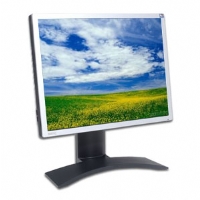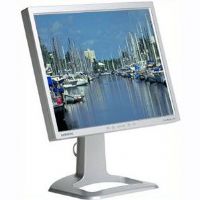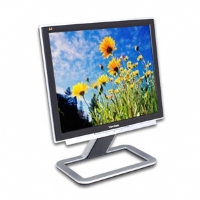Cheap Computer Monitors
August 14th, 2006 | Monitors
The computer monitor is the thing you stare at all day as you work on your computer. Because of this, choosing the right monitor can make a big difference to the strain experienced by your eyes when working, and the quality of the images you see on the screen.
There used to be very little option when getting a monitor, but there are getting to be more choices, which apart from giving you more choice makes it that little bit harder to choose the right one for your application.
This guide will give you enough information to make sure you get the monitor that best fits your needs, the applications you use, where you use it and most importantly is as light on your wallet as possible.
So what should I be looking for?
It used to be a fairly simple process to find the monitor that is best, but with the option of getting a CRT or LCD monitor and beyond that the quality and function of the monitor in question there becomes a lot more to consider. We will go over these to give you a good idea of what to keep your eyes open for.
We will look at whether you should get an LCD or CRT monitor, how to choose the best design of monitor, how good the monitor’s internal parts are, how well it produces colors, how uniform the colors are, latency and choosing the monitor that will meet the screen resolution you need and refresh rates.
If this seems like a bit much to take in, don’t worry we will go through each aspect clearly to make sure you know what to look out for.
Should I get an LCD or CRT?

Firstly let me explain the difference…
The old style monitor is the CRT. This stands for Cathode Ray Tube, which is the big thing inside the monitor that produces the picture. This kind of monitor is still the cheapest, but is bigger and heavier than LCD monitors. LCD monitors are dropping in price though, bringing them closer to the price of the older style monitors.
The newer, flatter monitors are LCD. This stands for Liquid Crystal Display and refers to the way the image is produced on the screen. These are generally about twice the price of CRT monitors, but offer other advantages like being more crisp, and not flickering at low refresh rates.
More recently the prices of LCD monitors have dropped dramatically. What I paid for a flat 19 inch CRT two years ago can now buy a 19 inch LCD monitor.
The most noticable difference is just in terms of style. The flat screen is much better for saving space on your table or desk, giving more room for other stuff. It is also much nicer to look at, that slim style gives it a more modern look.
There are drawbacks to LCD monitors though. Although CRT monitors all do fairly well, there is a huge range of quality to be found in flat screen monitors, some of the worst being almost unusable in reality. The best ones come at a high price. They also suffer from high latency, meaning that it takes a long time for the picture to come onto the screen. This is a serious issue for gamers, but not too serious for a desktop or workstation.
What size screen should I get?

If you are going to be doing gaming or graphics, bigger is better. It’s not the only thing to consider, but it makes a big difference, as you can fit more information on the screen. Unfortunately, as with many computer parts, the price goes up exponentially as the size increases. Basically, the best value is with 15 and 17 inch monitors. If you are looking at CRT monitors, you can still get good value with 19 inch monitors.
For most applications, a 15 inch monitor will do the job. The old standard used to be 14 inch, but these have more or less dissappeared. A 17 inch monitor provides a lot more monitor space as the measurements are made from corner to corner diagonally on the monitor. A 19 inch would suit a designer using 3D graphics programs or a gamer well.
Screen resolution
A computer screen is made up of thousands of little dots, that are close enough together to form an image.

How close these dots are to each other is refered to as the Dot Pitch. With any monitor you are looking for a dot pitch that is as small as possible.
If you are looking at two similar monitors, one with a .24 dot pitch and one with a .28 dot pitch, the one with the .24 dot pitch will have crisper image than the one with .28
With LCD monitors, the typical dot pitch is .264, while as low as .24 is possible for CRT monitors. For any monitor .28 is about as low as it goes, and you should not get any less than this.
Refresh rate
Refresh rate is how fast the monitor can produce a new image on the screen.
If you are doing something where the image is changing a lot, like when gaming, then a high refresh rate is very necessary. But if doing something like typing of surfing the net, this is not needed.
Higher refresh rates give you crisper images on the screen, too.
Resolution refers to how much information can be put on the screen. If the monitor is at 800×600 it means that it is showing 800 pixels across, and 600 vertically. By using a higher resolution you can fit more things on the monitor, but it also makes them appear smaller.
While surfing the web or word processing 800×600 is fine. More common with newer computers is 1024×768. I run my 19 inch monitor at 1280×960 and I can get a lot of information on one screen. Very useful when using programs like Adobe Photoshop.
When looking at a monitor, make sure it can support above 75hz@800×600 or even better 75hz@1024×768.
Design and ergonomics
The first thing to look at is how the monitor looks. This may seem like the most obvious thing, but there are details that you should look out for.
The part that surrounds the screen should be strong and resistant to scratches. If you are going to use more than one monitor together then it’s recommended that you get a screen with as small a border as possible.
Have a look at the buttons, are they easy to operate. Along with the buttons you should have a look at the On-Screen-Display (OSD). This is used to change the physical settings of the monitor. Is it intuitive and easy to use, is it easy to adjust the settings you want to change? Have a look at these little details.
Can you adjust it’s angle? How much can you adjust it? These are smaller details but are worth looking at when investing in a monitor.
Parts
Apart from the mere appearance of the monitor there are technical details that you should look out for as well.
There are many different kinds of video inputs that a monitor can take. Which ones you will use will depend on the application. A rule of thumb is to look for a monitor that has all of the ones you need. If it doesn’t, look at all the other features first, but make sure that it has at least the most common input sources.
There is the tradtional VGA port. This is the kind that was used on all CRT monitors and LCD monitors still use that kind. This is still the most common kind and you will not go wrong with a monitor that has a VGA port.
A DVI connector is another choice that is commonly found on LCD monitors. This is a newer kind that offere some advantages over the older VGA kind. It is very useful to have. There are very few flat screen monitors that don’t incluce one of these, but there are a handful that do not. Make sure it has the one that your computer uses or that your new computer has a kind to match.
S-Video connectors are useful if you plan to use things like your DVD player to play movies or your camcorder. Most home entertainment products will have an S-Video output so this would be good if you plan to play anything from those sources on your monitor.
Color and Spatial Uniformity
One problem that comes in with flat screen monitors is that the color produced on the screen is not always true to the color that it is supposed to be producing.
Although this may seem quite awful, the fact is that all LCD monitors have this to varying degrees. It’s how much difference there is that makes the difference.
Different spots on the screen will produce more or less accurate colors. If it varies too much between the top and the bottom of the screen, meaning that one of the two is more off, it will be obvious. If it is fairly well distributed over the screen then the difference will appear less.
The OSD is used to adjust the contrast and the brightness of the monitor. Sometimes a monitor needs to the brightness turned up really high to produce correct colors. This defeats the object of the LCD which is supposed to be easier on the eyes than a CRT monitor.
Latency
Latency refers to how fast the monitor can update the colors on the screen. Lower times mean a faster monitor and hence the picture stays up to date.
This has very little impact in the everyday monitor market, where the programs used, such as desktop applications don’t require this kind of speed. Those programs show nearly the same thing all the time.
But gaming is a whole new ballgame. The high refresh rates and precision graphics changing constantly and rapidly require the monitor to stay on top of things to keep it looking good, not to mention playable.
LCD monitors have always been on the slow side and CRT monitors would still be the choice to go for if gaming. However newer LCD monitors are coming up for the challlenge. With dropping prices and improving technology, new monitors are definitely in with a fighting chance for games.
If you are looking at first person shooter games, then a latency of under 12ms or even 8ms will be necessary to make the games playable. When a manufacturer specifies 12ms, that is under ideal conditions, and the latency can get as high as 36ms. This is a standard tactic, but is worth watching.
In Conclusion
Choosing the right monitor is a case of assessing your needs from the monitor itself. Many times, most monitors will be OK, especially when it comes to everyday desktop and office applications. Even then, taking the time to have a look for the most useful monitor will pay off with the ease of use they provide.
Monitors are one piece of equipment that can outlast all the other parts of your computer. Choosing the right monitor can save you from the need to upgrade for many years, adding to your computer’s ease of use, and making things easier, rather than a headache.





August 16th, 2006 at 5:46 pm
Branded computer monitors like viewsonics are still relatively better than second hand models. Second hand monitors can be cheap, but may not last a long time.
February 13th, 2007 at 12:48 pm
Branded models offer far much more assurance of quality than no name brand models. You will notice a few cheap monitors that look identical but have different brand names on them. They’re just rebranded by the manufacturer. I’d avoid these.
It is almost not necessary to get a second hand monitor anymore as the prices are very low. But many older CRT monitors will last for over a decade. I have a 19 inch Viewsonic p90f, which is now 5 years old, and has had the power supply fixed once, which was 3 years ago.